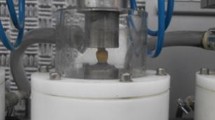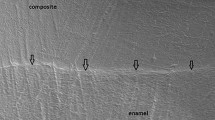Abstract
The aim of this study was to evaluate the effect of a rapid photopolymerization method on the marginal integrity of composite fillings. Ninety two-surface cavities were prepared in extracted human molars using the SonicSys preparation system. All cavities were bonded with one bonding agent (Syntac) and filled with a microfilled composite (Herculite XRV), a heavy filled composite (Z100 MP), and an Ormocer (Definite) in two increments. Each increment had a thickness of approximately 1.5 mm and was polymerized using either halogen light or the plasma light of Apollo 95 E. In this process, six trial groups each containing 15 fillings were created. After replicas were made, the test teeth were subjected to a thermocycling process of 2000 temperature cycles (5°C/55°C) followed by a wear simulation of 50,000 stress cycles each with 50 N. This was followed by the creation of a second set of replicas, quantitative margin analysis, and dye penetration. A significant (P<0.05) influence of the thermomechanical stress and a significant (P<0.05) influence of the factor ”material” were shown for the margin criterion ”continuous margin” using MANOVA. The factor ”light source” produced no significant influence (P=0.57) on the amount of continuous margin. During the dye penetration, no significant differences between the polymerization methods could be established with the materials Herculite XRV and Z100 MP (H-test according to Kruskall and Wallis). Only with the material Definite was a significantly higher dye penetration observed at the occlusal measuring point in the plasma light group. A rapid polymerization with high light intensity had no adverse effects on the margin quality within the limitations of this in vitro study. However the marginal integrity might have been influenced by the chosen adhesive system/composite resin combination, which does not represent the respective product line. Additionally, further studies ought to show which exposure time is necessary for a sufficient degree of conversion.
Similar content being viewed by others

Author information
Authors and Affiliations
Additional information
Received: 24 June 1999 / Accepted: 22 November 1999
Rights and permissions
About this article
Cite this article
Stoll, R., Kook, K., Kunzelmann, KH. et al. Influence of a high-speed polymerization method on the marginal integrity of composite fillings in class-II cavities. Clinical Oral Investigations 4, 42–49 (2000). https://doi.org/10.1007/s007840050112
Issue Date:
DOI: https://doi.org/10.1007/s007840050112



